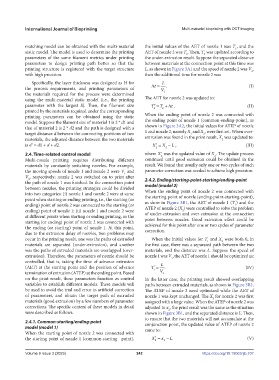Page 250 - IJB-9-3
P. 250
International Journal of Bioprinting Multi-material bioprinting with OCT imaging
matching model can be obtained with the multi-material the initial values of the AET of nozzle 1 was T , and the
1
static model. The model is used to determine the printing AET of nozzle 2 was T . Then, T was updated according to
2
2
parameters of the same filament metrics under printing the under-extrusion result. Suppose the separated distance
parameters to design printing path better so that the between materials at the connection point at this time was
printing structure is registered with the target structure L, as shown in Figure 3A1 and the speed of nozzle 2 was V ,
2
with high precision. then the additional time for nozzle 2 was
Specifically, the layer thickness was designed as H for L
the process requirements, and printing parameters of t V . (I)
the materials required for the process were determined 2
using the multi-material static model (i.e., the printing The AET for nozzle 2 was updated to:
parameter with the largest S). Then, the filament size T 2 T 2 t . (II)
printed by the materials required under the corresponding
printing parameters can be obtained using the static When the ending point of nozzle 2 was connected with
model. Suppose the filament size of material 1 is 2 * d1 and the ending point of nozzle 1 (common-ending-point), as
that of material 2 is 2 * d2 and the path is designed with a shown in Figure 3A2, the initial values for ATEP of nozzle
target distance d between the connecting positions of two 1 and nozzle 2, namely X and X , were first set. When over-
1
2
materials, the adjusted distance between the two materials extrusion was found in the print result, X was updated to:
2
is dʹ = d1 + d + d2. X 2 X 2 L , (III)
2.4. Time-related control model where Xʹ was the updated value of X . The update process
2
2
Multi-nozzle printing requires distributing different continued until good extrusion could be obtained in the
materials by constantly switching nozzles. For example, result. We found that usually only one or two cycles of such
the moving speeds of nozzle 1 and nozzle 2 were V and parameter correction was needed to achieve high precision.
1
V , respectively; nozzle 2 was switched on to print after
2
the path of nozzle 1 was finished. In the connection point 2.4.2. Ending/starting-point-starting/ending-point
between nozzles, the printing strategies could be divided model (model 2)
into two categories: (i) nozzle 1 and nozzle 2 were at same When the ending point of nozzle 2 was connected with
point when starting or ending printing, i.e., the starting (or the starting point of nozzle (ending-point-starting-point),
ending) point of nozzle 2 was connected to the starting (or as show in Figure 3B1, the AET of nozzle 1 (T ) and the
1
ending) point of nozzle 1; (ii) nozzle 1 and nozzle 2 were ATEP of nozzle 2 (X ) were controlled to solve the problem
2
at different points when starting or ending printing, so the of under-extrusion and over-extrusion at the connection
starting (or ending) point of nozzle 2 was connected with point between nozzles. Good extrusion effect could be
the ending (or starting) point of nozzle 1. At this point, achieved for this point after one or two cycles of parameter
due to the extrusion delay of nozzles, two problems may correction.
occur in the printing result, one was the paths of extruded When the initial values for T and X were both 0, in
2
1
materials are separated (under-extrusion), and another the first case, there was a separated path between the two
was the paths of extruded materials are overlapped (over- materials, and the distance was L. Suppose the speed of
extrusion). Therefore, the parameters of nozzle should be nozzle 1 was V , the AET of nozzle 1 should be optimized as:
1
controlled, that is, taking the time of advance extrusion L
(AET) at the starting point and the position of advance T 1 . (IV)
termination of extrusion (ATEP) at the ending point. Based V 1
on the print result, these parameters function as control In the latter case, the printing result showed overlapping
variables to establish different models. These models will paths between extruded materials, as shown in Figure 3B2.
be used to avoid the trial and error in artificial correction The ATEP of nozzle 2 need optimized while the AET of
of parameters, and obtain the target path of extruded nozzle 1 was kept unchanged. The X for nozzle 2 was first
2
materials (good extrusion) by a few numbers of parameter assigned with a large value. When the ATEP of nozzle 2 was
corrections. The specific content of these models in detail adjusted to x , the print result was the same as the situation
2
were described as follows. shown in Figure 3B1, and the separated distance is L. Then,
to ensure that the two materials will not accumulate at the
2.4.1. Common-starting/ending-point conjunction point, the updated value of ATEP of nozzle 2
model (model 1) came to:
When the starting point of nozzle 2 was connected with
the starting point of nozzle 1 (common-starting -point), X x 2 L. (V)
2
Volume 9 Issue 3 (2023) 242 https://doi.org/10.18063/ijb.707

